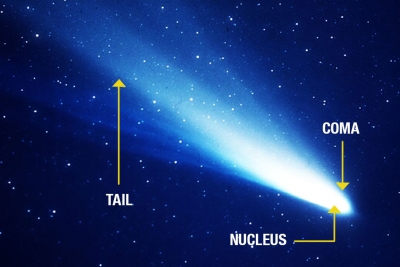
The nucleus is the solid core of a comet consisting of frozen molecules including water, carbon monoxide, carbon dioxide, methane and ammonia as well as other inorganic and organic molecules — dust. According to ESA the nucleus of a comet is usually around 10 kilometers across or less.
Comets are separated into three distinct parts called the tail, nucleus and the coma which ensures its workability. Comets work in the sense that they tend to be more explicit when they come closer to the source of illumination, the Sun. The tail of a comet is made up of three other parts, the ion tail, the hydrogen envelope, and the dust tail. All these are also vital for the movement of the comet both to and from the sun as indicated below.
The nucleus of a comet is made up of ice, gas, dust, and rocks. It is found right at the center of the head of a comet. The nucleus of a comet is often frozen. The part which is occupied by the gas in the comet’s nucleus is made up of carbon dioxide, the carbon monoxide, ammonia, and methane.
The comet’s area which is made up of the nucleus encompasses between 0.6 to around 6 miles. At times, it is even more than this distance. The nucleus, following this combination of materials, carries the most mass of the comet. The nucleus of a comet is also regarded as one of the darkest objects ever witnessed in the space.
Credit : Earth eclipse
Picture Credit : Google




